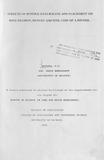| dc.description.abstract | The effects of residue mulch rate and placement on infiltration,
runoff and soil loss was stu~ied under natural rainfall on a 16%
slope of humic nitisol at Kabete, Nairobi, Kenya.
The study had five treatments which were replicated three times.
The treatments were, distributed mulch at a rate of 1.5 t/ha,
distributed mulch at a rate of 3 t/ha, lined (trashlined) mulch at
a rate of 1.5 t/ha, lined (trashlined) mulch at a rate of 3 t/ha,
and control with no mulch. In total, there were 15 plots, each of
2 m by 10 m. Maize crop residues were used. Two way analysis of
variance (ANOVA) and Duncan' s multiple range test were used in
comparing the treatment effect on infiltration, runoff and soil
loss. The experiment was cropped with beans during, the short rains
1992. Maize planted during the long rains 1993 failed due to
drought.
Results showed that:
,The mulch treatment effect was significant in increasing
infiltration and reducing runoff and soil losses. Distributed mulch
at 3 tjha, lined mulch at 3 tjha, distributed mulch at 1.5 tjha and
lined mulch at 1.5 t/ha reduced soil loss by 78 %, 74 %, 60 % and
50 % of that from the unmulched (control) plot respectively.
Further, 1ined mulch at 3 tjha, distributed mulch at 3 tjha,
distributed mulch at 1.5 tjha and lined mulch at 1.5 tjha reduced
runoff volume by 69 %, 67 %, 54 % and 44 % of the control's runoff
respectively. Infiltration depth was deepest in lined mulch at 3
t/ha followed by distributed mulch at 3 t/ha, distributed mulch at
1.5 t/ha, lined mulch at 1.5 t/ha and control respectively.
Analysis of variance (ANOVA) showed that there were significant
differences in runoff and soil loss among the treatments at P=l%.
Comparison of the treatments using Duncan's method showed that only
the control treatment was significantly different from the mulch
treatments at P = 0.05. However, there was no significance
difference in infiltration depth among the treatments. The mulch
treatments significantly increased crop yield. Comparison of the
treatments using Duncan's method showed that yield from the control
was significantly less than that obtained from treated plots at
P = 0.05.
It was concluded that use of low cost soil and water conservation
methods, like use of crop residues, should be encouraged. Where
crop residue is scarce, low rates should still be used as they will
be better than nothing. Where crop residue is abundant, high rates
would have a beneficial effect. Depending on the availability of
crop residue, labour, and type of farm operations which take
place, a farmer could be advised to use either distributed or lined
mulch at 1.5 t/ha or 3 t/ha. However, where only very small
quantities of mulch are available, the farmer could be advised to
use it together with other conservation methods as it has been
shown that small quantities of mulch will not- be adequate to
control soil and water losses during heavy storms. All these would
enable the resource poor farmer to control soil and water losse.
and eventually increase crop yield. | en |

